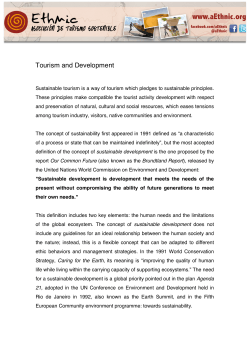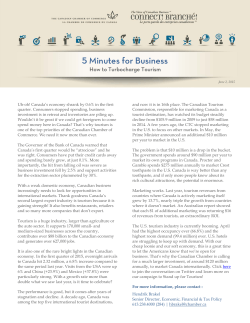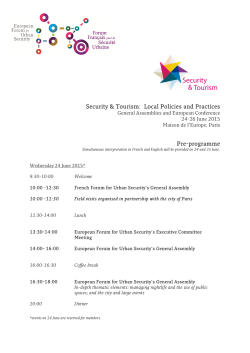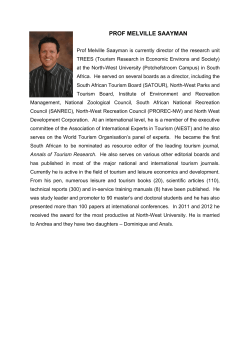
Estimating passenger mobility by tourism statistics
Estimating passenger mobility by tourism statistics Paolo Bolsi DG MOVE - Unit A3 Economic Analysis and Impact Assessment 2nd International Transport Forum Statistical meeting 1-2 April 2015 Transport Passenger mobility statistics Passenger mobility statistics are fundamental for economic analysis of mobility in Europe; While there is sufficient availability of freight transport data for Europe, the passenger sector lacks harmonized statistical indicators for some modes of transport; Some countries in Europe collect passenger mobility data, with own methodology and often with a focus on urban and short distance mobility; Total passenger mobility (expressed in passenger-kilometres, i.e. the total distance travelled by passengers) is measured directly through surveys or estimated indirectly by using auxiliary information, such as traffic counts and odometer readings. Transport Passenger mobility by distance classes Passenger mobility statistics by distance classes are an important tool to assess the specialization of different transport modes: • short distance (less than 300km); • medium distance (between 300 and 1000 km); • long distance (over 1000 km). Transport Tourism statistics Collected under Regulation (EU) 692/2011, data is collected by member states through specific tourism surveys; As for 2012, Eurostat has access to the information on the trips characteristics for each tourist trip, also the main mode of transport used; Tourism statistics report the number of tourism trips from the country of residence of the respondents to the country of destination of the tourism trip, for each main mode of transport and for all member states; Some of the definitions used are different than those common to transport statistics. Transport Tourism statistics - definitions Tourism means the activity of visitors taking a trip to a main destination outside the usual environment, for less than a year, for any main purpose, including business, leisure or other personal purpose, other than to be employed by a resident entity in the place visited. Usual environment is defined as the geographical area, though not necessarily a contiguous one, within which an individual conducts his regular life routines and shall be determined on the basis of the following criteria: the crossing of administrative borders or the distance from the place of usual residence, the duration of the visit, the frequency of the visit, the purpose of the visit'. (from Eurostat 2012 Methodological manual: http://ec.europa.eu/eurostat/documents/3859598/5923373/KS-RA-11-021-EN.PDF/2f1474d7-17eb4587-b4c7-a90800b43464?version=1.0) Transport Tourism statistics - definitions Tourist trip: A visitor (domestic, inbound or outbound) is classified as a tourist (or overnight visitor), if his/her trip includes an overnight stay, or as a same-day visitor (or excursionist) otherwise. A “tourist trip” is considered by tourism statistics as a roundtrip travel – different than in transport statistics! (from Eurostat 2012 Methodological manual: http://ec.europa.eu/eurostat/documents/3859598/5923373/KS-RA-11-021-EN.PDF/2f1474d7-17eb4587-b4c7-a90800b43464?version=1.0) Transport Tourism statistics - definitions Main mode of transport: rail, motor vehicles, air, waterways, bus and coaches, other. (waterway and other not considered in the methodology) Criterion to determine the main mode of transport: 1) Distance; 2) Cost; For international transport, also the means of transport used to cross the borders of the countries visited, especially when referring to islands. (from Eurostat 2012 Methodological manual: http://ec.europa.eu/eurostat/documents/3859598/5923373/KS-RA-11-021-EN.PDF/2f1474d7-17eb4587-b4c7-a90800b43464?version=1.0) Transport Tourism and passenger mobility Tourism statistics may offer valuable information on passenger mobility on the medium-long distance: - Trips outside the usual environment of the visitor; - Condition of the overnight stay; - Purpose of the trips which considers leisure, professional and personal purposes. Tourism statistics provide trips from the country of residence of the respondent to the main country of destination of the trip. Can this information be converted in passenger-kilometres by distance classes? Transport Example: from FR to DE In 2012, 840601 tourism trips by motor vehicle, done by French visitors to Germany. Transport Example: from FR to DE But the distance depends from the origin and the destination of the trip… for example: A trip from Metz to Frankfurt -> 250 km (short distance); A trip from Paris to Cologne -> 500 km (medium distance); A trip from Montpellier to Berlin -> 1600 km (long distance). How to derive passenger-km indicators by distance classes? Probabilities are used: trips are extracted from an universe of possible trips between regions (NUTS2), each pair associated with a distance taken from a distance matrix (WebILSE). Transport Assumption of the calculation • A tourist trip -> 2 transport trips; • Main mode of transport -> Sole mode of transport; • Main destination of the trip -> Sole destination of the trip; • No tourist trips within the same NUTS2 region; • Distance travelled described by the distance matrix; • A single inland distance matrix (rail and road together); • Probabilities calculated regardless of the distance between regions and of the mode of transport used, but based on number of residents (for country of residence) and number of arrivals (for country of destination). Transport Probability Matrix Inland transport: for each NUTS2 to NUTS2 combination between European country, probabilities to extract a trip are determined by two factors: • For the country of residence: population by NUTS2 regions, divided by the total population. • For the country of destination: number of tourist arrivals in the NUTS2 regions compared to the total arrivals. - For national passenger transport: number of arrivals of residents; - For international passenger transport: number of arrivals of nonresidents. Air Transport: for each airport pair, probabilities are calculated according to the passenger carried between the airport, compared to the total passengers between two countries. Transport Probability Matrix The probabilities for international passenger transport between two regions x and y are calculated under hypothesis of independence: 𝐼𝑁𝑇𝐸𝑅𝑁𝐴𝑇𝐼𝑂𝑁𝐴𝐿 = 𝑝𝑂𝑅𝐼𝐺𝐼𝑁 ∗ 𝑝 𝐷𝐸𝑆𝑇𝐼𝑁𝐴𝑇𝐼𝑂𝑁 𝑝𝑥,𝑦 𝑥 𝑦 The probabilities for national passenger transport between two regions x and y are calculated under hypothesis of semi-independence: 𝑁𝐴𝑇𝐼𝑂𝑁𝐴𝐿 = 0, 𝑝𝑥,𝑥 𝑁𝐴𝑇𝐼𝑂𝑁𝐴𝐿 = 𝑝𝑥,𝑦 𝑝𝑥𝑂𝑅𝐼𝐺𝐼𝑁 ∗ 𝑝𝑦𝐷𝐸𝑆𝑇𝐼𝑁𝐴𝑇𝐼𝑂𝑁 1− Transport 𝑂𝑅𝐼𝐺𝐼𝑁 𝑖 𝑝𝑖 ∗ 𝑝𝑖𝐷𝐸𝑆𝑇𝐼𝑁𝐴𝑇𝐼𝑂𝑁 Calculating passenger-km The distance matrices are divided into three matrices, according to the length of the distance between each pair of NUTS2 regions or each pair of airports: Short (<300 km), medium (300-1000 km) and long distance (>1000 km). Passenger-km are calculated as follows: • probabilities are multiplied by the respective distance between NUTS2 regions (or airports); • results are aggregated for each country of residence and each country of destination; • aggregates are multiplied for each trip reported by tourism statistics, distinguished by mode; • results are further aggregated for the whole EU. Transport Calculating passenger-km Passenger activity for inland mode of transport t in the medium distance (3001000 km): 𝑂𝑟𝑖𝑔𝑖𝑛 𝐷𝑒𝑠𝑡𝑖𝑛𝑎𝑡𝑖𝑜𝑛 𝑡 𝑝𝑘𝑚300−1000 =𝑆∗ 300−1000 𝑝𝑖,𝑗 𝑑𝑖𝑠𝑡𝑖,𝑗 𝑇𝑟𝑖𝑝𝑠𝑡 𝐶𝑜𝑢𝑛𝑡𝑟𝑖𝑒𝑠 𝑖= 𝑁𝑈𝑇𝑆2 𝑗=𝑁𝑈𝑇𝑆2 Passenger activity for inland mode of transport t in the long distance (>1000 km): 𝑂𝑟𝑖𝑔𝑖𝑛 𝐷𝑒𝑠𝑡𝑖𝑛𝑎𝑡𝑖𝑜𝑛 𝑡 𝑝𝑘𝑚>1000 =𝑆∗ >1000 𝑝𝑖,𝑗 𝑑𝑖𝑠𝑡𝑖,𝑗 𝑇𝑟𝑖𝑝𝑠𝑡 𝐶𝑜𝑢𝑛𝑡𝑟𝑖𝑒𝑠 𝑖= 𝑁𝑈𝑇𝑆2 𝑗=𝑁𝑈𝑇𝑆2 Passenger activity for inland mode of transport t in the short distance (<300 km) – derived by difference from total passenger-km (DG MOVE Statistical Pocketbook): 𝑡 𝑡 𝑡 𝑡 𝑝𝑘𝑚<300 = 𝑝𝑘𝑚𝑡𝑜𝑡𝑎𝑙 − 𝑝𝑘𝑚300−1000 − 𝑝𝑘𝑚>1000 Transport Calculating passenger-km Passenger activity for air transport in the medium distance (300-1000 km): 𝑂𝑟𝑖𝑔𝑖𝑛 𝑎𝑖𝑟 𝑝𝑘𝑚300−1000 =𝑆∗ 𝐷𝑒𝑠𝑡𝑖𝑛𝑎𝑡𝑖𝑜𝑛 300−1000 𝑝𝑖,𝑗 𝑑𝑖𝑠𝑡𝑖,𝑗 𝑇𝑟𝑖𝑝𝑠𝑎𝑖𝑟 𝐶𝑜𝑢𝑛𝑡𝑟𝑖𝑒𝑠 𝑖= 𝑎𝑖𝑟𝑝𝑜𝑟𝑡 𝑗= 𝑎𝑖𝑟𝑝𝑜𝑟𝑡 Passenger activity for air transport in the long distance (>1000 km): 𝑂𝑟𝑖𝑔𝑖𝑛 𝑎𝑖𝑟 𝑝𝑘𝑚>1000 =𝑆∗ 𝐷𝑒𝑠𝑡𝑖𝑛𝑎𝑡𝑖𝑜𝑛 >1000 𝑝𝑖,𝑗 𝑑𝑖𝑠𝑡𝑖,𝑗 𝑇𝑟𝑖𝑝𝑠𝑎𝑖𝑟 𝐶𝑜𝑢𝑛𝑡𝑟𝑖𝑒𝑠 𝑖= 𝑎𝑖𝑟𝑝𝑜𝑟𝑡 𝑗=𝑎𝑖𝑟𝑝𝑜𝑟𝑡 Passenger activity for air transport in the short distance (<300 km): 𝑂𝑟𝑖𝑔𝑖𝑛 𝑎𝑖𝑟 𝑝𝑘𝑚<300 =𝑆∗ 𝐷𝑒𝑠𝑡𝑖𝑛𝑎𝑡𝑖𝑜𝑛 <300 𝑝𝑖,𝑗 𝑑𝑖𝑠𝑡𝑖,𝑗 𝑇𝑟𝑖𝑝𝑠𝑎𝑖𝑟 𝐶𝑜𝑢𝑛𝑡𝑟𝑖𝑒𝑠 𝑖= 𝑎𝑖𝑟𝑝𝑜𝑟𝑡 𝑗=𝑎𝑖𝑟𝑝𝑜𝑟𝑡 Transport Calibration: scale factor The scale factor S is needed to adapt the estimates derived from the tourism statistics to the size and coverage of general passenger transport statistics. Air transport is used to calculate the scale factor since in theory every air transport trip could be considered as a tourist trip. The coefficient is derived as a ratio between the total passenger-km for air transport from DG MOVE Statistical Pocketbook and the total passenger-km derived from the calculations. Its value correspond to 2.1. The scale factor could be interpreted as a calibration factor to harmonize this methodology to the size of passenger mobility statistics. Transport Resulting estimates Rail activity by distance class Bus & Coach activity by distance class % 50 45 % 90 80 40 70 35 60 30 50 25 20 40 15 30 10 20 5 10 0 below 300 300-1000 0 more 1000 below 300 300-1000 more 1000 Rail transport seems a medium distance mode of transport, as 46% of the trips are estimated to be performed within the range of 300-1000 km. Bus and coach transport seems mostly used in short distance trips, for almost 80% of the trips, as the share of trips below 300 km includes also urban bus transport. Transport Resulting estimates % Motor vehicle activity by distance class 80 70 Aviation activity by distance class % 90 80 70 60 60 50 50 40 40 30 30 20 20 10 10 0 0 below 300 300-1000 more 1000 below 300 300-1000 more 1000 Motor vehicles are mostly used in short distance trips, although 23% of passenger transport activity seems performed on the medium distance. Aviation is confirmed to be a mode of transport for long distance trips, as 76% of the estimated activity falls on the long distance class. Transport Conclusions The methodology offers a first attempt to estimate passenger activity by distance classes from the tourist trips performed within Europe. There may be methodological synergies between transport and tourism statistics, which are useful to exploit. Tourism statistics contains information on medium and long distance passenger transport, covering also private modes of transport for which less statistical information is available. They could be a good source of information to complement existing statistics. Many assumptions and estimates are necessary to convert tourism data into transport activity indicators! Transport Areas of improvements The methodology should be tested further (e.g. when 2013 data will be available for all member states) and there are different areas of improvement: - The availability of regional tourism data would greatly improve the results; - Data on tourist arrivals distinguished by nationality of the guest would also provide a better modelling of travel behaviour, allowing a better calibration of the results; - Any additional information on secondary mode of transport used would greatly improve the results; - A rail distance matrix would make rail estimates more concrete. Transport Thank you for your attention Transport
© Copyright 2025









